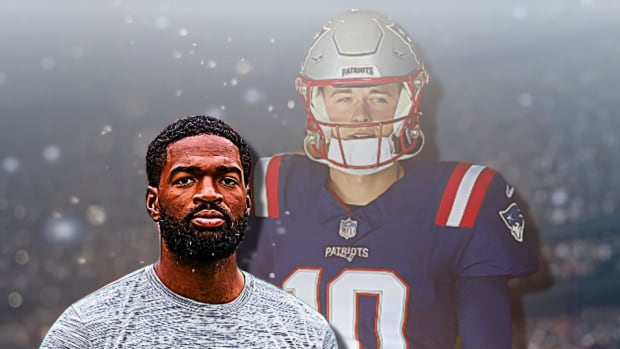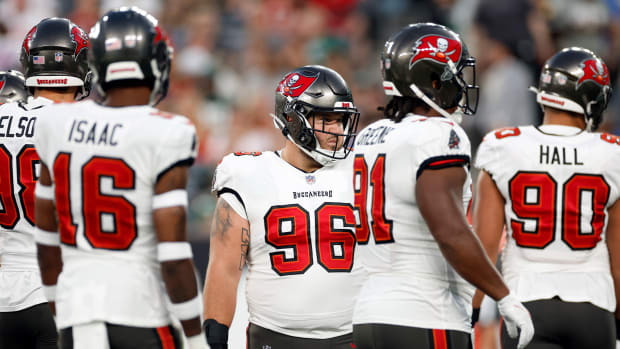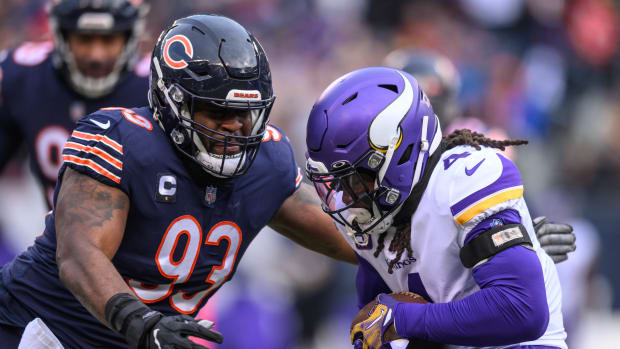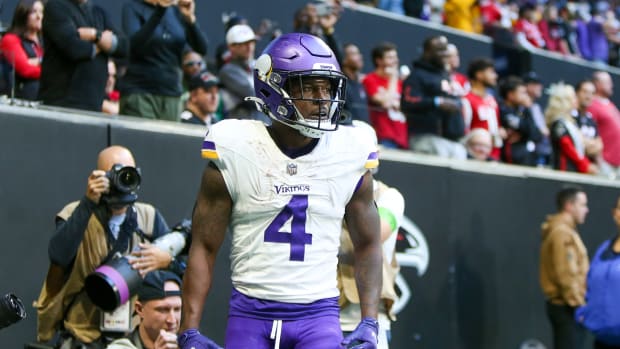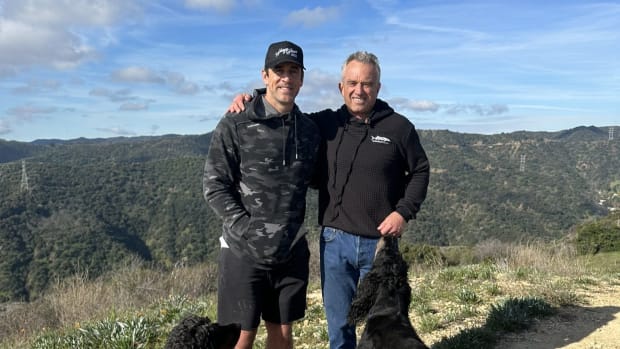2017 NFL draft first impressions: Stanford OL Johnny Caspers
Your teams on the go or at home. Personalize SI with our new App. Install on iOS or Android.
It is never too early to start preparing for the next NFL draft. From now through the start of the college football season, FirstImpressions will introduce (or reintroduce) you to prospects of note.
When he officially announced his list of 2012 signees, Stanford coach David Shaw called the group “one of the best recruiting classes in school history.” His assessment was proven correct, at least along the offensive line.
Included among that class were first-round picks Andrus Peat and Joshua Garnett, as well as eventual sixth-rounder Kyle Murphy and center Graham Shuler, a full-time starter from 2014–15. And even with that quartet now gone, the Cardinal still have two ’12 recruits remaining up front: guards Brandon Fanaika and Johnny Caspers.
The latter now stands as the most experienced member of an O-line tasked with blocking for 2015 Heisman runner-up and ’16 Heisman favorite Christian McCaffrey. Caspers (6' 4", 296 lbs.) is locked in at right guard, but he served last season as the Cardinal’s center in short-yardage and goal-line situations.
His offensive coordinator, Mike Bloomgren, believes that limited experience could be a sign of things to come for Caspers.
“He could definitely start at center for us,” Bloomgren tells SI. “That’s probably how he projects next level.”
Bloomgren says that “in a perfect world,” he will be able to keep Caspers at guard 100% of the time this coming season because Stanford “lost the ability to pull” from the right guard spot when Caspers slid to center. Pulling, from various positions, is a centerpiece of the Stanford run game. Caspers drew an offer from Stanford in large part because he was impressive in that regard as a high schooler, according to Bloomgren, but it took a little while for the Glen Ellyn, Ill. product to translate that skill to the college ranks.
Playoffs or bust? Raiders have pieces in place to return to postseason
“I was so impressed by his ability to pull [in high school], but he came in at like 255 pounds,” Bloomgren says. “Then he was like that awkward child who’s grown too much. He was eating six PB&J’s before bedtime, put on weight, wasn’t moving the way I thought he should. But he grew into his body ...
“He’s made tremendous improvements as a puller. He’s become a much better football player here.”
Stanford still needs him to be better, particularly as a pass blocker.
“He’s good there, he’s not elite at this time,” Bloomgren explains. “Pass protection, although it’s improved dramatically, it’s still not at an All-American level. Am I hopeful he can do that this year? Sure I am. And he had a great spring.”
The Cardinal play-caller connects any of Caspers’s deficiencies to his form: “He is such a technician in the weight room, in the run game, but he doesn’t utilize the same technique and the correct hand placement 100% of the time.”
Oddly enough, Caspers had fewer issues pass blocking during his reps at center than he did while playing guard, which is the opposite of how such cases usually go. “He’s the only player I’ve ever been around to do that,” Bloomgren says.
Truth detector: Derrick Henry taking on pass-catching role with Titans?
NFL teams love having “swing“ linemen—prospects capable of handling multiple positions, right out of the gate, so Caspers’s time spent bouncing between guard and center only will bolster his case come draft time. So, too, will his background in the Cardinal’s pro-style attack and the growing history of successful NFL players from the school. Caspers has studied yet another Stanford product, 2012 Steelers draft pick David DeCastro, at length in hopes of fine-tuning his own game. Caspers will likely draw less pre-draft attention than DeCastro, Murphy or Peat did, but he is almost certain to hear his name called.
“He is a physical, physical player, as tough as any lineman who played here for us,” says Bloomgren, who also repeatedly talked up Caspers’s ascension as a locker-room leader this off-season. “His strength is a strength. He can anchor his base. His ability to drive block, pick a target and continue running through it is something he’s improved on tremendously—taking a target and keeping it north, not getting flattened out like he did freshman and sophomore year.
“Good size for a spot like center. He’s not a tackle, doesn’t have the height or length for it, so you talk about the guard and center spot. ... His approach to the game, how he studies it is next-level stuff.”
Second opinion of Johnny Caspers
Each First Impressions column will feature a deeper dive on our featured prospect, from Sports Illustrated NFL producer Eric Single. Here are his thoughts on Caspers.
If you watched only one clip of Stanford’s offensive line last year, it was this Vine. Left guard Joshua Garnett (now with the 49ers) takes no prisoners as he paves the way downfield for fullback Daniel Marx on a screen pass, with the rest of the O-line picking off Washington defenders along the way. Caspers’s brief cameo in that Vine—he swings into the picture in the bottom right-hand corner to run level with Marx, pointing out blocks as he runs out of frame—displays how comfortable he is in open space at the second level, which shows up on tape time after time in less highlight-worthy scenarios. His most common mistakes come in tight-area run blocking situations, when the occasional false step or whiff puts him on the defensive, but he was a reliable cog on Cardinal units that seem to have sent everybody to the NFL over the past three years.
• BURKE: Breakout players to know ahead of 2016 season
Now, it’s his turn to lead the O-line from the inside. His ability to anchor himself in pass protection against bigger defenders makes him an invaluable stabilizing force, whether he takes the field for the 2016 season opener at his incumbent starting right guard spot or at center, where he has been mentioned as a possible replacement for the departed Graham Shuler. He may not steamroll people in the style that made Garnett a cult sensation, but he could follow his former teammate’s lead in challenging the ceiling that interior offensive line prospects face in the NFL evaluation process.
Which other talented prospects should you have on your 2017 draft radar? Here are a few more to consider:
Brady Gustafson, QB, Montana
A tall, strong-armed quarterback from a high-powered FCS offense…where have we heard that one before? Gustafson will try to follow in Carson Wentz’s footsteps by propelling himself up draft boards with a stellar senior season. The Montana gunslinger has even less experience under his belt than Wentz did ahead of 2015, having started just seven career games—Gustafson missed several weeks last year with a leg injury.
2017 NFL draft first impressions: Corey Davis’s polished WR skill set
What’s to like: The size (6' 7", 230 lbs.) and the arm, for starters. Gustafson can stretch the field with an easy release, but he also can zip it into tight spots when he takes the time and has the space to finish his throws. While he does not appear quite as athletic as Wentz, Gustafson does offer decent mobility. Montana’s creative Bob Stitt offense (which Inside the Pylon has done a terrific job breaking down) allowed Gustafson to carry the ball on the occasional read-option; he also seems comfortable throwing off rollouts, and can slide his feet in the pocket to dodge pressure.
What needs work: His accuracy. Gustafson tossed nine interceptions on 290 pass attempts last season, a high turnover rate of 3.1%. Four of those INTS came in a playoff loss to North Dakota State, one of the two game videos included below. (The other is of Montana’s season-opening upset of Wentz-led NDSU.) His completion percentage of 57.5 is even more troubling given how many easy hits are built in to the Stitt system via fly sweeps and screens. As mentioned, Gustafson has the arm to squeeze passes into tight windows, but only when he steps into his throws—too many attempts are arm-only, off his back foot.
Early outlook: It is inevitable though unfair that Gustafson will draw Wentz comparisons all season long. Setting the bar at Wentz’s No. 2 draft spot is far too lofty for where Gustafson is as a QB right now. He shapes as more of a mid-round project, especially given the system he will be coming out of, but his potential could drive him into Round 1 or 2 of an uncertain quarterback class.
[youtube:https://www.youtube.com/watch?v=f87I9qRMnmo]
Mike Williams, WR, Clemson
Were it not for the scary injury Williams suffered in Clemson’s 2015 season-opener—he fractured a bone in his neck colliding with the goal post—chances are good that he would have been mentioned among the Corey Colemans and Laquon Treadwells early in Round 1 of the ’16 draft. Williams averaged 18.1 yards on his 57 catches as a sophomore and was primed for an even bigger junior season. He opted not to apply for a medical redshirt despite playing less than one game last year, so this will be his final go-round with Clemson.
What’s to like: Just about everything, at least when taking into consideration that Williams still has a full season to develop. At 6' 4" and 220 lbs., Williams has the frame NFL teams drool over at the WR spot, and he looks to have room to bulk up even more. He brings an outstanding catch radius, both on deep balls and working the sideline. As of 2014, at least, Williams also showed an understanding of how to find holes in coverage—several of his catches came as he extended routes while his quarterbacks (Cole Stoudt and Deshaun Watson) extended plays. Williams plays with exceptional balance, as well. Health willing, he’ll be a big-play and red-zone threat as soon as he arrives in the NFL.
What needs work: Williams has to clean up his route running, as is often the critique of college receivers. The threat he brings downfield often causes DBs to back off him, but Williams must take better advantage of that by not rounding off his routes. It also would be nice to see a player of his size be even more physical. From time to time, Williams will let cornerbacks come through him to break up passes and his blocking is a bit more of the in-the-way variety than dominating.
Early outlook: His injury was no joke, so while the word thus far is that he will be ready to go come September, we’ll have to see if it affects him at all. Is he still willing to throw himself into contact situations or does he hold back? If the Williams of 2016 is a more complete version of what he was in 2014, he will be headed toward the top 20.
Eddie Vanderdoes, DT, UCLA
Another prospect whose NFL arrival likely was delayed a year by a season-ending injury. As was the case with Williams, Vanderdoes did not make it beyond the 2015 opener, when he tore his ACL vs. Virginia. He now will be asked to help replace Kenny Clark (picked No. 28 overall by Green Bay in April). A redshirt junior, Vanderdoes does already have 20 career starts. He recorded 50 tackles during the ’14 campaign and had eight against Virginia before falling with his injury.
Wiedmeier was a refreshing contrast to weak leadership elsewhere in NFL
What’s to like: Vanderdoes is a definite contender to be one of Mike Mayock’s “bubble butt” All-Stars—the NFL Network analyst loves using that term to describe linemen with stocky, powerful lower bodies. And, indeed, at 6' 3" and 305 lbs., Vanderdoes brings some thunder up front. He is not necessarily just a space-eater, though—at least prior to his injury he had the quick feet to move laterally, backed by good awareness for which direction a play was headed. Versatility is another key, as UCLA can line him up in 0-, 1- and 3-tech locales.
What needs work: For Vanderdoes to be a playmaker at the next level, he will have to be consistent getting off the ball. The extra beat he needed off the snap at times was especially noticeable next to Clark, who boasts a great first step. Improvement there could help Vanderdoes be more effective as a pass rusher, too—he has just 2.5 career sacks. ’’
Early outlook: The keys for Vanderdoes come down to his health and three-down potential. There is no doubt that, fully healthy, he can be a factor vs. the run. That often is not enough to sell NFL teams on a first-round choice, so making a few more plays in the backfield would serve Vanderdoes well. Pencil him in as a late-Round 1, early-Round 2 option, assuming he is all the way back from his injury this season.
[youtube:https://www.youtube.com/watch?time_continue=144&v=KLpImUUjkGg]
Josh Harvey-Clemons, S, Louisville
An 11-game starter for Georgia in 2013, Harvey-Clemons transferred to Louisville the following season after the Bulldogs dismissed him for a violation of team rules. He reportedly dabbled with the idea of entering this year’s draft before sticking in school. Harvey-Clemons (6' 5", 212 lbs.) posted 88 tackles and three interceptions last season, both numbers he could top in ’16 as an All-America candidate.
What’s to like: Harvey-Clemons is tailor-made for the modern NFL—a hybrid safety/linebacker/slot corner with the confidence to handle his job any of those places. He moves all over the field, including playing single-high in coverage, but he really appears to prefer crashing the line. The Cardinals even used him as a blitzer out of the slot once in awhile. There are times that he attacks for a thunderous hit; more often, he breaks down and wraps up with solid technique.
What needs work: A common theme for defenders who thrive charging downhill is that they can be susceptible to overcommitting, and such is the case for Harvey-Clemons. Misdirection will catch him leaning. This leads to another factor to watch: his speed. There is plenty there for Harvey-Clemons to play in the box, but the difference between being a defender with 4.4- and 4.6-second 40-yard speed is massive as it pertains to surviving in the slot of as a deep safety.
Early outlook: Deone Bucannon (and to a lesser extent, Mark Barron) have helped usher in a promising era for defensive prospects with the versatile skill set Harvey-Clemons shows. How he ultimately tests as a straight-line runner could determine whether he lands in Round 1 or slides to Day 2.
































